Telemedicine and Healthcare Administration: Challenges and Changes
VerifiedAdded on 2022/09/08
|6
|1382
|21
Project
AI Summary
This project delves into the transformative impact of telemedicine on healthcare administration. It begins with an introduction outlining the background, complexity, and importance of healthcare administration, especially in the context of modern care delivery. The project highlights telemedicine as a crucial innovation that changes how healthcare services are delivered, including clinical care, remote consultations, and hospital admissions. It explores the benefits of telemedicine, such as increased accessibility and cost efficiency, while also addressing challenges like knowledge gaps, technology limitations, and communication deficits. The statement of the problem focuses on the technological and knowledge-based competencies needed for administrators to manage data flow, protection, and integration. The purpose of the research is to understand how telemedicine has changed health administration. The project's objectives include assessing the effects of telemedicine technologies on healthcare administrators, assumptions, and limitations, such as variations in health service delivery and technological access in remote areas. The project also defines key terms like 'telemedicine' and 'healthcare administration' and provides references to support the analysis.
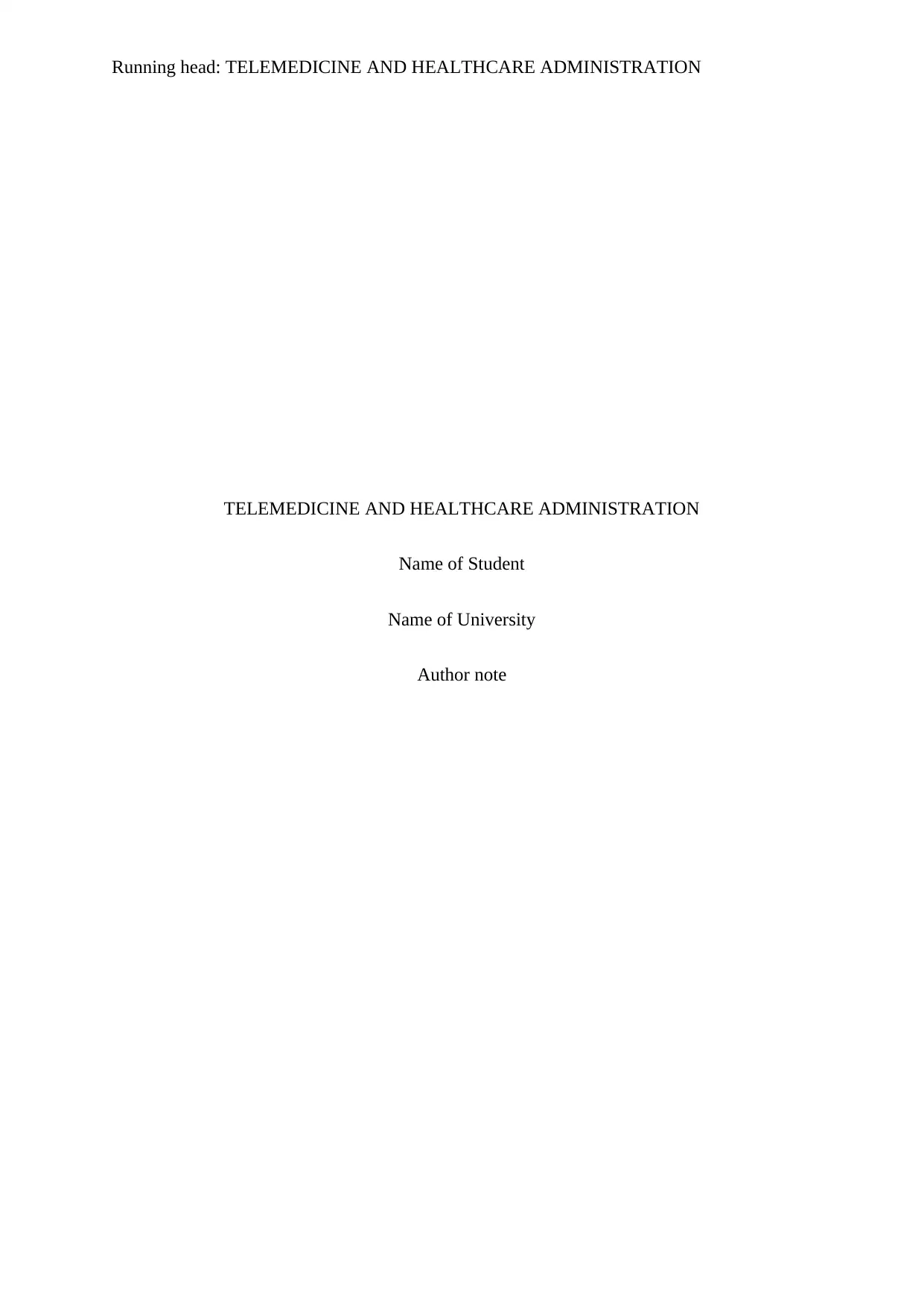
Running head: TELEMEDICINE AND HEALTHCARE ADMINISTRATION
TELEMEDICINE AND HEALTHCARE ADMINISTRATION
Name of Student
Name of University
Author note
TELEMEDICINE AND HEALTHCARE ADMINISTRATION
Name of Student
Name of University
Author note
Paraphrase This Document
Need a fresh take? Get an instant paraphrase of this document with our AI Paraphraser
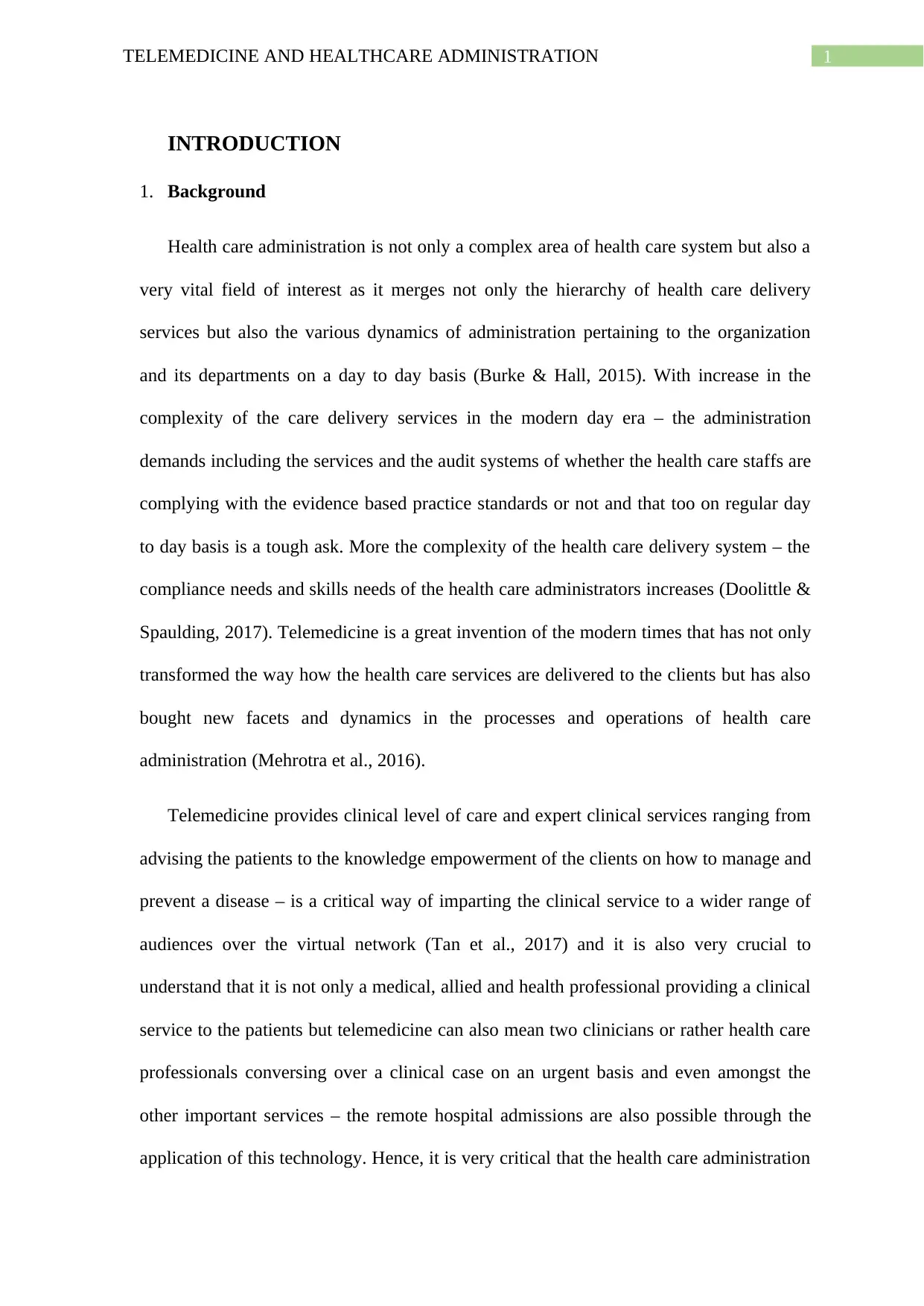
1TELEMEDICINE AND HEALTHCARE ADMINISTRATION
INTRODUCTION
1. Background
Health care administration is not only a complex area of health care system but also a
very vital field of interest as it merges not only the hierarchy of health care delivery
services but also the various dynamics of administration pertaining to the organization
and its departments on a day to day basis (Burke & Hall, 2015). With increase in the
complexity of the care delivery services in the modern day era – the administration
demands including the services and the audit systems of whether the health care staffs are
complying with the evidence based practice standards or not and that too on regular day
to day basis is a tough ask. More the complexity of the health care delivery system – the
compliance needs and skills needs of the health care administrators increases (Doolittle &
Spaulding, 2017). Telemedicine is a great invention of the modern times that has not only
transformed the way how the health care services are delivered to the clients but has also
bought new facets and dynamics in the processes and operations of health care
administration (Mehrotra et al., 2016).
Telemedicine provides clinical level of care and expert clinical services ranging from
advising the patients to the knowledge empowerment of the clients on how to manage and
prevent a disease – is a critical way of imparting the clinical service to a wider range of
audiences over the virtual network (Tan et al., 2017) and it is also very crucial to
understand that it is not only a medical, allied and health professional providing a clinical
service to the patients but telemedicine can also mean two clinicians or rather health care
professionals conversing over a clinical case on an urgent basis and even amongst the
other important services – the remote hospital admissions are also possible through the
application of this technology. Hence, it is very critical that the health care administration
INTRODUCTION
1. Background
Health care administration is not only a complex area of health care system but also a
very vital field of interest as it merges not only the hierarchy of health care delivery
services but also the various dynamics of administration pertaining to the organization
and its departments on a day to day basis (Burke & Hall, 2015). With increase in the
complexity of the care delivery services in the modern day era – the administration
demands including the services and the audit systems of whether the health care staffs are
complying with the evidence based practice standards or not and that too on regular day
to day basis is a tough ask. More the complexity of the health care delivery system – the
compliance needs and skills needs of the health care administrators increases (Doolittle &
Spaulding, 2017). Telemedicine is a great invention of the modern times that has not only
transformed the way how the health care services are delivered to the clients but has also
bought new facets and dynamics in the processes and operations of health care
administration (Mehrotra et al., 2016).
Telemedicine provides clinical level of care and expert clinical services ranging from
advising the patients to the knowledge empowerment of the clients on how to manage and
prevent a disease – is a critical way of imparting the clinical service to a wider range of
audiences over the virtual network (Tan et al., 2017) and it is also very crucial to
understand that it is not only a medical, allied and health professional providing a clinical
service to the patients but telemedicine can also mean two clinicians or rather health care
professionals conversing over a clinical case on an urgent basis and even amongst the
other important services – the remote hospital admissions are also possible through the
application of this technology. Hence, it is very critical that the health care administration
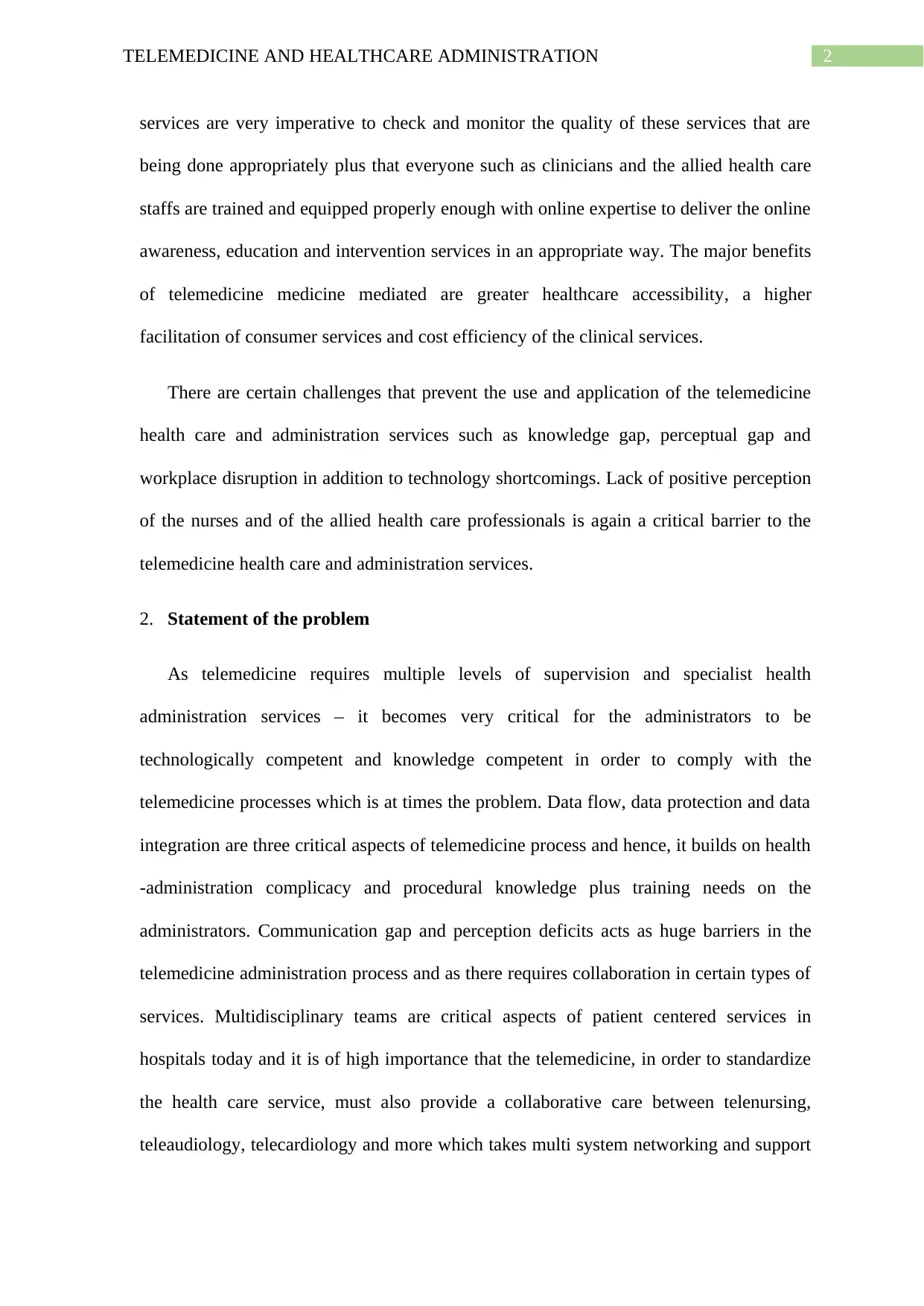
2TELEMEDICINE AND HEALTHCARE ADMINISTRATION
services are very imperative to check and monitor the quality of these services that are
being done appropriately plus that everyone such as clinicians and the allied health care
staffs are trained and equipped properly enough with online expertise to deliver the online
awareness, education and intervention services in an appropriate way. The major benefits
of telemedicine medicine mediated are greater healthcare accessibility, a higher
facilitation of consumer services and cost efficiency of the clinical services.
There are certain challenges that prevent the use and application of the telemedicine
health care and administration services such as knowledge gap, perceptual gap and
workplace disruption in addition to technology shortcomings. Lack of positive perception
of the nurses and of the allied health care professionals is again a critical barrier to the
telemedicine health care and administration services.
2. Statement of the problem
As telemedicine requires multiple levels of supervision and specialist health
administration services – it becomes very critical for the administrators to be
technologically competent and knowledge competent in order to comply with the
telemedicine processes which is at times the problem. Data flow, data protection and data
integration are three critical aspects of telemedicine process and hence, it builds on health
-administration complicacy and procedural knowledge plus training needs on the
administrators. Communication gap and perception deficits acts as huge barriers in the
telemedicine administration process and as there requires collaboration in certain types of
services. Multidisciplinary teams are critical aspects of patient centered services in
hospitals today and it is of high importance that the telemedicine, in order to standardize
the health care service, must also provide a collaborative care between telenursing,
teleaudiology, telecardiology and more which takes multi system networking and support
services are very imperative to check and monitor the quality of these services that are
being done appropriately plus that everyone such as clinicians and the allied health care
staffs are trained and equipped properly enough with online expertise to deliver the online
awareness, education and intervention services in an appropriate way. The major benefits
of telemedicine medicine mediated are greater healthcare accessibility, a higher
facilitation of consumer services and cost efficiency of the clinical services.
There are certain challenges that prevent the use and application of the telemedicine
health care and administration services such as knowledge gap, perceptual gap and
workplace disruption in addition to technology shortcomings. Lack of positive perception
of the nurses and of the allied health care professionals is again a critical barrier to the
telemedicine health care and administration services.
2. Statement of the problem
As telemedicine requires multiple levels of supervision and specialist health
administration services – it becomes very critical for the administrators to be
technologically competent and knowledge competent in order to comply with the
telemedicine processes which is at times the problem. Data flow, data protection and data
integration are three critical aspects of telemedicine process and hence, it builds on health
-administration complicacy and procedural knowledge plus training needs on the
administrators. Communication gap and perception deficits acts as huge barriers in the
telemedicine administration process and as there requires collaboration in certain types of
services. Multidisciplinary teams are critical aspects of patient centered services in
hospitals today and it is of high importance that the telemedicine, in order to standardize
the health care service, must also provide a collaborative care between telenursing,
teleaudiology, telecardiology and more which takes multi system networking and support
⊘ This is a preview!⊘
Do you want full access?
Subscribe today to unlock all pages.

Trusted by 1+ million students worldwide
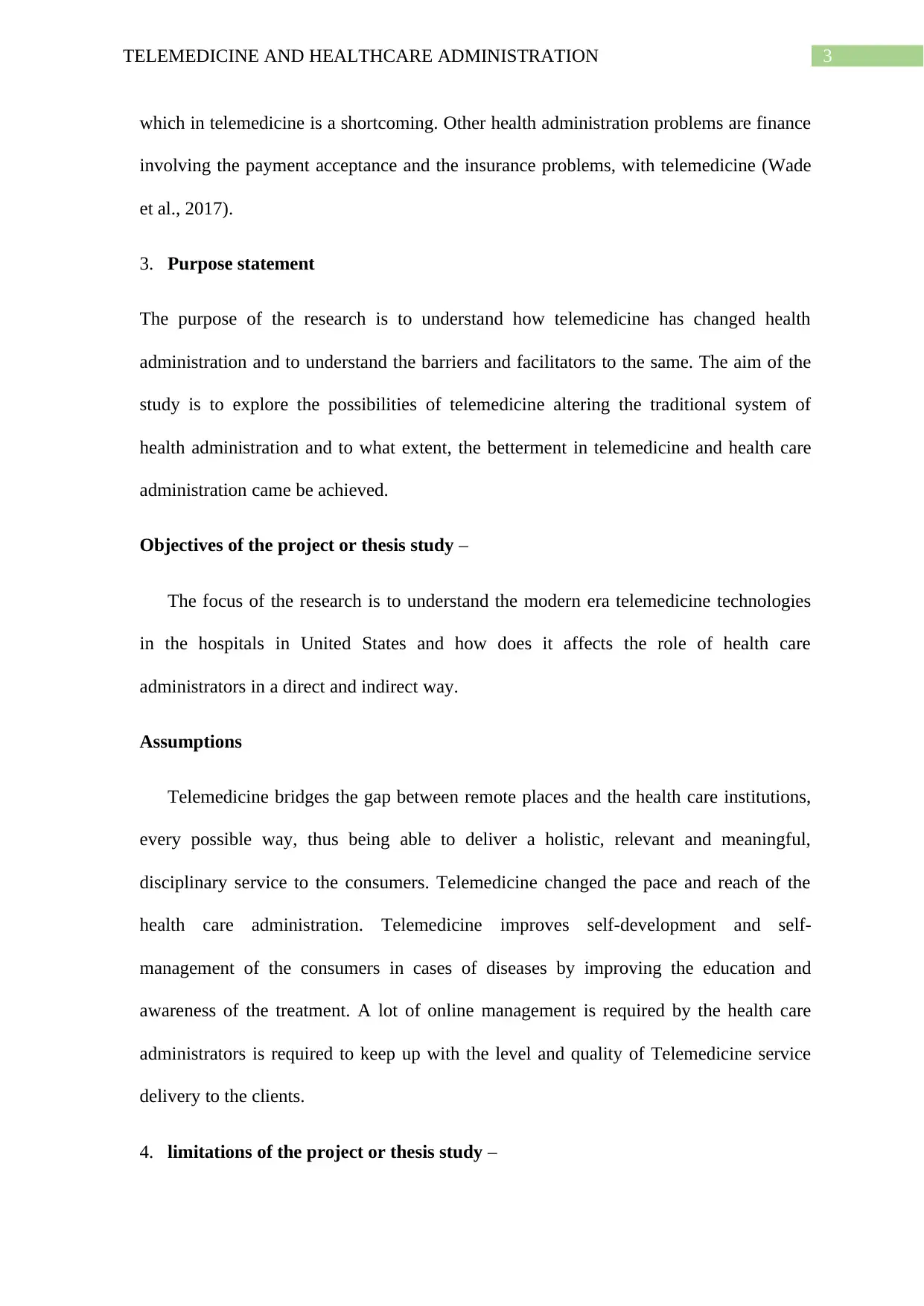
3TELEMEDICINE AND HEALTHCARE ADMINISTRATION
which in telemedicine is a shortcoming. Other health administration problems are finance
involving the payment acceptance and the insurance problems, with telemedicine (Wade
et al., 2017).
3. Purpose statement
The purpose of the research is to understand how telemedicine has changed health
administration and to understand the barriers and facilitators to the same. The aim of the
study is to explore the possibilities of telemedicine altering the traditional system of
health administration and to what extent, the betterment in telemedicine and health care
administration came be achieved.
Objectives of the project or thesis study –
The focus of the research is to understand the modern era telemedicine technologies
in the hospitals in United States and how does it affects the role of health care
administrators in a direct and indirect way.
Assumptions
Telemedicine bridges the gap between remote places and the health care institutions,
every possible way, thus being able to deliver a holistic, relevant and meaningful,
disciplinary service to the consumers. Telemedicine changed the pace and reach of the
health care administration. Telemedicine improves self-development and self-
management of the consumers in cases of diseases by improving the education and
awareness of the treatment. A lot of online management is required by the health care
administrators is required to keep up with the level and quality of Telemedicine service
delivery to the clients.
4. limitations of the project or thesis study –
which in telemedicine is a shortcoming. Other health administration problems are finance
involving the payment acceptance and the insurance problems, with telemedicine (Wade
et al., 2017).
3. Purpose statement
The purpose of the research is to understand how telemedicine has changed health
administration and to understand the barriers and facilitators to the same. The aim of the
study is to explore the possibilities of telemedicine altering the traditional system of
health administration and to what extent, the betterment in telemedicine and health care
administration came be achieved.
Objectives of the project or thesis study –
The focus of the research is to understand the modern era telemedicine technologies
in the hospitals in United States and how does it affects the role of health care
administrators in a direct and indirect way.
Assumptions
Telemedicine bridges the gap between remote places and the health care institutions,
every possible way, thus being able to deliver a holistic, relevant and meaningful,
disciplinary service to the consumers. Telemedicine changed the pace and reach of the
health care administration. Telemedicine improves self-development and self-
management of the consumers in cases of diseases by improving the education and
awareness of the treatment. A lot of online management is required by the health care
administrators is required to keep up with the level and quality of Telemedicine service
delivery to the clients.
4. limitations of the project or thesis study –
Paraphrase This Document
Need a fresh take? Get an instant paraphrase of this document with our AI Paraphraser
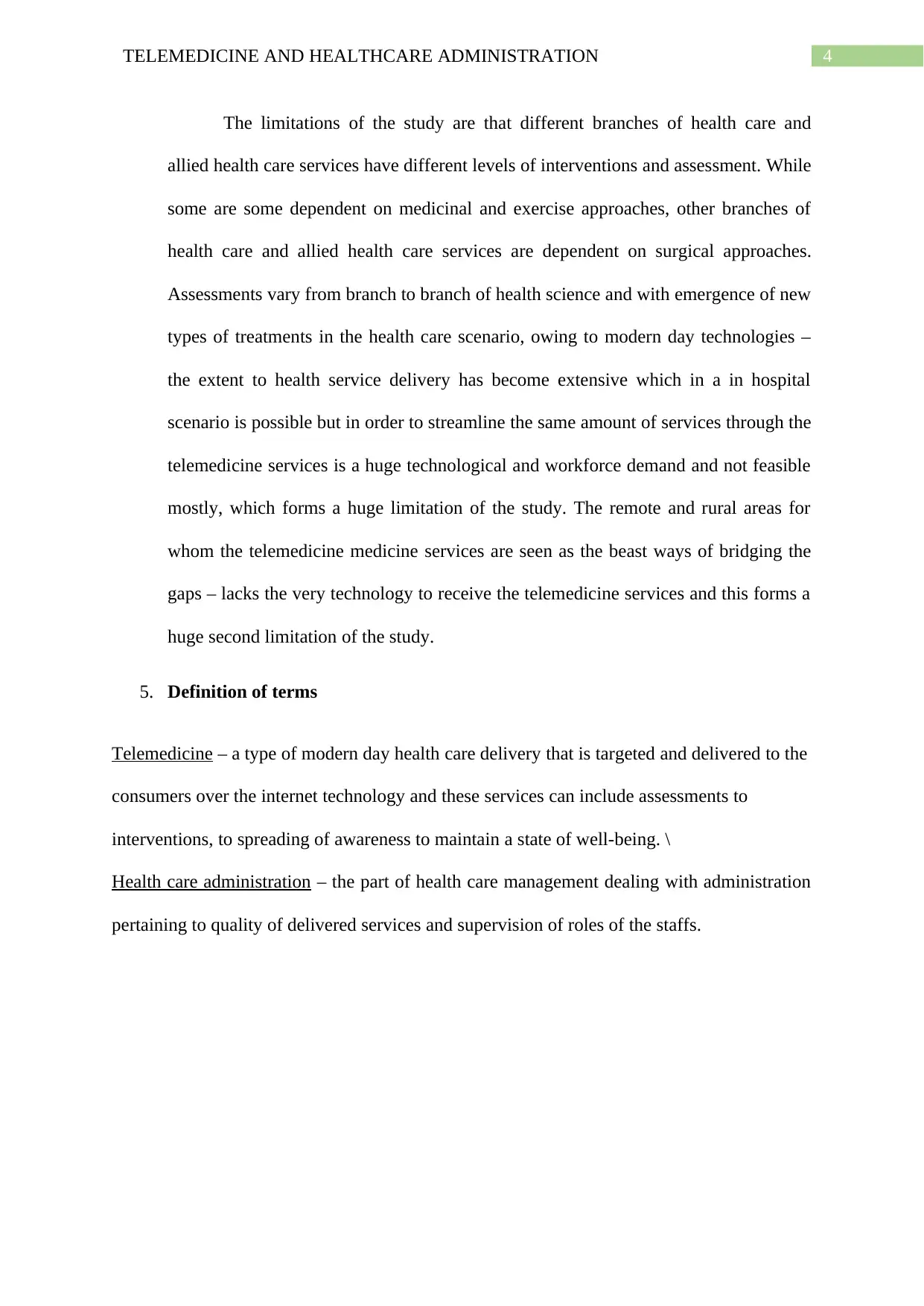
4TELEMEDICINE AND HEALTHCARE ADMINISTRATION
The limitations of the study are that different branches of health care and
allied health care services have different levels of interventions and assessment. While
some are some dependent on medicinal and exercise approaches, other branches of
health care and allied health care services are dependent on surgical approaches.
Assessments vary from branch to branch of health science and with emergence of new
types of treatments in the health care scenario, owing to modern day technologies –
the extent to health service delivery has become extensive which in a in hospital
scenario is possible but in order to streamline the same amount of services through the
telemedicine services is a huge technological and workforce demand and not feasible
mostly, which forms a huge limitation of the study. The remote and rural areas for
whom the telemedicine medicine services are seen as the beast ways of bridging the
gaps – lacks the very technology to receive the telemedicine services and this forms a
huge second limitation of the study.
5. Definition of terms
Telemedicine – a type of modern day health care delivery that is targeted and delivered to the
consumers over the internet technology and these services can include assessments to
interventions, to spreading of awareness to maintain a state of well-being. \
Health care administration – the part of health care management dealing with administration
pertaining to quality of delivered services and supervision of roles of the staffs.
The limitations of the study are that different branches of health care and
allied health care services have different levels of interventions and assessment. While
some are some dependent on medicinal and exercise approaches, other branches of
health care and allied health care services are dependent on surgical approaches.
Assessments vary from branch to branch of health science and with emergence of new
types of treatments in the health care scenario, owing to modern day technologies –
the extent to health service delivery has become extensive which in a in hospital
scenario is possible but in order to streamline the same amount of services through the
telemedicine services is a huge technological and workforce demand and not feasible
mostly, which forms a huge limitation of the study. The remote and rural areas for
whom the telemedicine medicine services are seen as the beast ways of bridging the
gaps – lacks the very technology to receive the telemedicine services and this forms a
huge second limitation of the study.
5. Definition of terms
Telemedicine – a type of modern day health care delivery that is targeted and delivered to the
consumers over the internet technology and these services can include assessments to
interventions, to spreading of awareness to maintain a state of well-being. \
Health care administration – the part of health care management dealing with administration
pertaining to quality of delivered services and supervision of roles of the staffs.
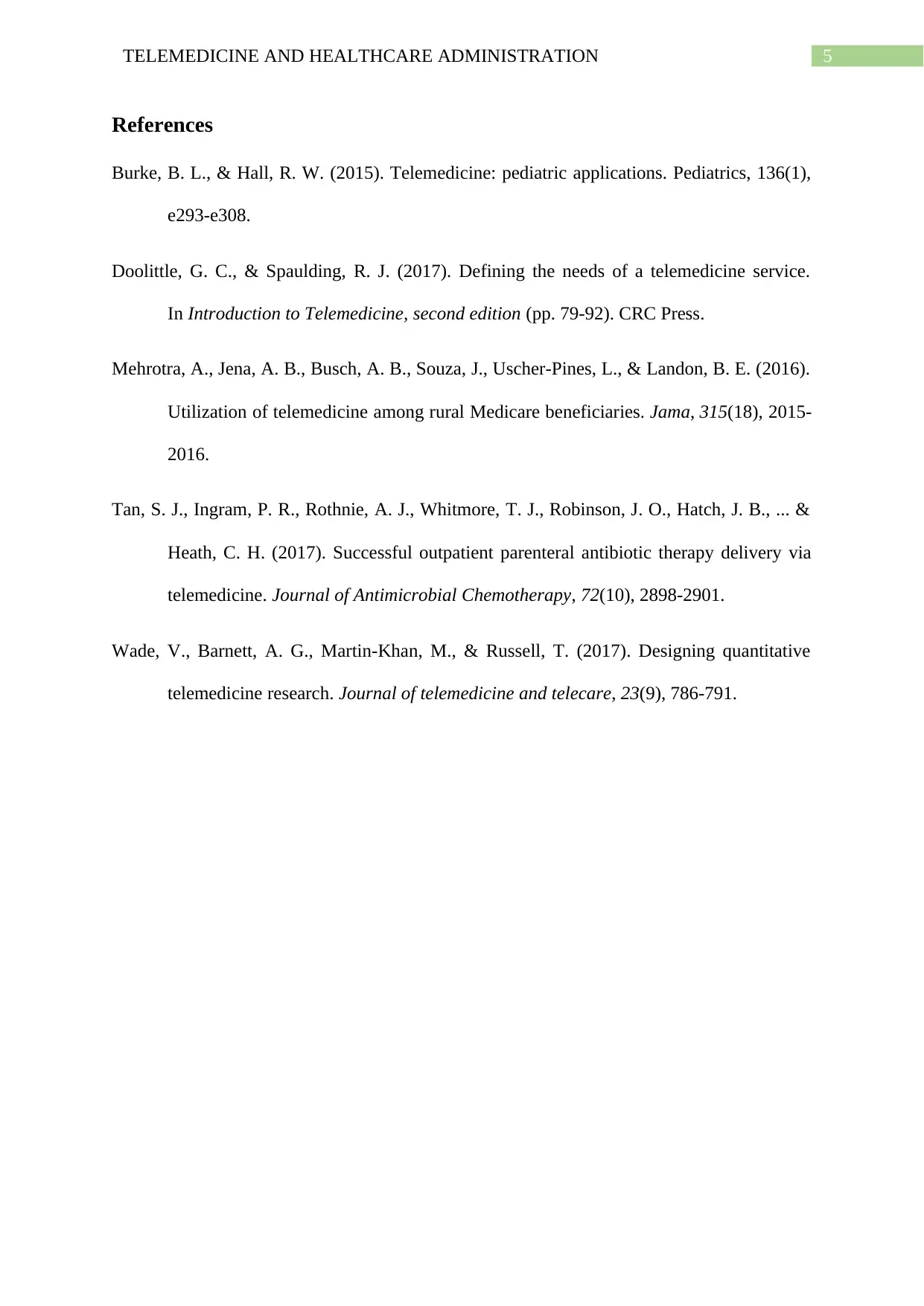
5TELEMEDICINE AND HEALTHCARE ADMINISTRATION
References
Burke, B. L., & Hall, R. W. (2015). Telemedicine: pediatric applications. Pediatrics, 136(1),
e293-e308.
Doolittle, G. C., & Spaulding, R. J. (2017). Defining the needs of a telemedicine service.
In Introduction to Telemedicine, second edition (pp. 79-92). CRC Press.
Mehrotra, A., Jena, A. B., Busch, A. B., Souza, J., Uscher-Pines, L., & Landon, B. E. (2016).
Utilization of telemedicine among rural Medicare beneficiaries. Jama, 315(18), 2015-
2016.
Tan, S. J., Ingram, P. R., Rothnie, A. J., Whitmore, T. J., Robinson, J. O., Hatch, J. B., ... &
Heath, C. H. (2017). Successful outpatient parenteral antibiotic therapy delivery via
telemedicine. Journal of Antimicrobial Chemotherapy, 72(10), 2898-2901.
Wade, V., Barnett, A. G., Martin-Khan, M., & Russell, T. (2017). Designing quantitative
telemedicine research. Journal of telemedicine and telecare, 23(9), 786-791.
References
Burke, B. L., & Hall, R. W. (2015). Telemedicine: pediatric applications. Pediatrics, 136(1),
e293-e308.
Doolittle, G. C., & Spaulding, R. J. (2017). Defining the needs of a telemedicine service.
In Introduction to Telemedicine, second edition (pp. 79-92). CRC Press.
Mehrotra, A., Jena, A. B., Busch, A. B., Souza, J., Uscher-Pines, L., & Landon, B. E. (2016).
Utilization of telemedicine among rural Medicare beneficiaries. Jama, 315(18), 2015-
2016.
Tan, S. J., Ingram, P. R., Rothnie, A. J., Whitmore, T. J., Robinson, J. O., Hatch, J. B., ... &
Heath, C. H. (2017). Successful outpatient parenteral antibiotic therapy delivery via
telemedicine. Journal of Antimicrobial Chemotherapy, 72(10), 2898-2901.
Wade, V., Barnett, A. G., Martin-Khan, M., & Russell, T. (2017). Designing quantitative
telemedicine research. Journal of telemedicine and telecare, 23(9), 786-791.
⊘ This is a preview!⊘
Do you want full access?
Subscribe today to unlock all pages.

Trusted by 1+ million students worldwide
1 out of 6
Related Documents
Your All-in-One AI-Powered Toolkit for Academic Success.
+13062052269
info@desklib.com
Available 24*7 on WhatsApp / Email
![[object Object]](/_next/static/media/star-bottom.7253800d.svg)
Unlock your academic potential
Copyright © 2020–2025 A2Z Services. All Rights Reserved. Developed and managed by ZUCOL.





